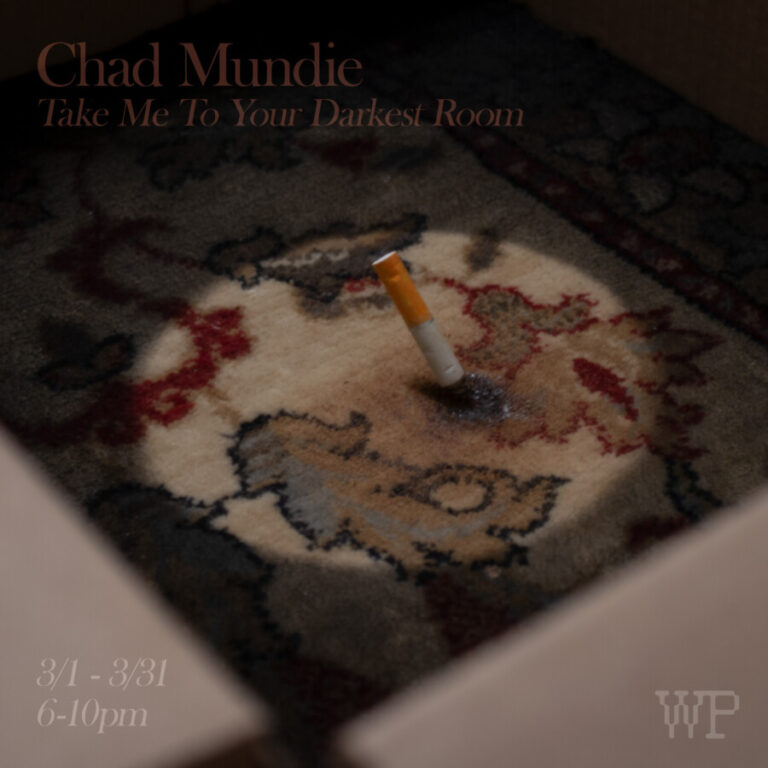Chad Mundie: Take Me To Your Darkest Room
@ Weatherproof
3336 W Lawrence Ave, #303, Chicago, IL 60625
Opening Friday, March 1st, from 6PM - 10PM
On view through Sunday, March 31st
Weatherproof is excited to announce ‘Take Me To Your Darkest Room’, with work from Richmond, VA-based artist Chad Mundie, opening Friday March 1st, from 6-10pm.
Squeeze machines are devices used in therapeutic applications for individuals who are hypersensitive to stimuli. Originally created by Temple Grandin, an American animal behaviorist, the first iterations of the device were made of wood and padded with cushions, equipped with pulleys for the user to apply pressure onto themselves. It was similar to that of a cocoon, a cavern for the user to simulate a hug or comforting physical touch without the closeness of another human being. Much like a home or a domestic space, the squeeze machine is constructed with wooden studs to delineate the interior from the exterior, a group of barriers that have been erected to disrupt the atmosphere; one to provide shelter, the other to induce calming. Its origins came from a cattle chute; Grandin had seen a calf enter such a machine when it was in distress, squeezing it on either side. This stabilization would induce a calming effect. A staple in narratives surrounding overlooked children in suburban contexts are hiding beneath stairs, in basements, behind doors, the architectural characteristics providing physical shielding from emotional tumult, womb-like in their implementation. How dwarfed are humans to their own constructions? These same protective household locations are often the darker nooks of the structure, apt for lurking, or at the least presenting the prospect of a situation that would make one want to turn on another light or two when left alone.
Skinamarinky-dinky-dink.
The structure of the home and the body, too, are not dissimilar: both contain independent systems to perform functions. Within Chad Mundie’s solo exhibition “Take Me To Your Darkest Room” the artist has presented an installation, containing a video work that splices footage from an endoscope traveling through a cow’s colon with footage from the same camera traveling through the pipes of his family home in Virginia, the internal structures of cattle mimicking the form of heating and plumbing systems in American residential structures. The work functions to collapse the mechanical and biological systems into a disorientation of contrast and similarity. To an extent, this collapse exists in pop culture as the trope of a Sapient House, a domestic structure being a haunting entity within itself, structurally fluid when needed, the architecture of physiology being mirrored in the layout and use of its compartments by the family unit. The consciousness of the structure is usually unearthed, hidden then alive, built up, stewarded, tainted by the actualization of some emotional and familial bond with ‘the house’ turned sour. These are fundamentally still structures of care and support, reversed into malice in their indignation; a former, protective host twisting to inflict suffering upon its guests.
Temple Grandin was best known for her innovations in cattle handling; implementing features within slaughterhouses that shielded the cows from the sight of their peers being killed in line ahead of them. She was considered to be a major force to be reckoned with regarding the humane treatment of cows, a species that was very much beloved by her. But her considerations fell short, seeing as the animals were slaughtered nonetheless. To Grandin, it was not detrimental that the cows were killed, it was detrimental that the cows could acknowledge that they would be killed; she liked cows and she wanted to spare them the fright of their own demise. This was fundamentally a question of consciousness.
How estranged are we from our own creations and how distant are our bodies from the structures we have built for them to reside within? Humans are at the top of the food chain because of their own contributions to technology rather than biological advantages. Without the structure of the home how long would we last? Considering self-awareness and the lengths at which it impairs us as a species, our readiness to read into supportive structures and systems makes them ripe for reversal into the very things that haunt, maim, and kill us.
Skinamarinky-doo.
—
Chad Mundie (born 1996, Fredericksburg, VA) recreates speculative memories and arrangements of the home and its inhabitants as a means of exploring how energy, relationships, narrative, and architecture blur and refocus into new forms through sculpture, video, and writing. He received his BA from the University of Mary Washington in 2018, and his MFA from Virginia Commonwealth University in 2022. His work has been exhibited at Candela Gallery, Tuesday, and Cherry in Richmond and Harvestworks in New York City.
Official Website
More events on this date
Tags: Albany Park, Chad Mundie, Chad Mundie: Take Me To Your Darkest Room, Take Me To Your Darkest Room, Weatherproof

« previous event
next event »